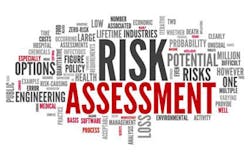Sometimes it takes a major accident to realize that your safety system did meet your company standards. That was the case for Mondelez International. The company lost nine colleagues in an accident at one of its plants. A buildup of a combustible dust in the cooling system, which had never occurred in any other plant dealing with the same substance, caused an explosion.
That accident stunned the company who immediately shut down plants and reviewed safety systems explained, Susan Lotter, sssociate director Risk Americas, Mondelez International, during a presentation at SLC 2017.
“We thought we had been doing safety correctly, so we had to rethink our processes,” said Lotter. “We had to build process safety into our core safety program.”
Mondelez, a $26 billion manufacturer of brands such as Oreo, Chips Ahoy!, Trident gum and Halls cough drops, turned to DEKRA Insight to help build a robust system.
Michael D. Snyder, vice president of ProcessSafety of DEKRA Insight was a co-presenter at SCL. He had been recognized by EHS Today Magazine in 2013 and 2015 as one of the 50 most influential leaders in EHS and risk management.
Recently his company announced a set of measurable disciplines, the AIER scales, which address the historically ambiguous approach to evaluating high-reliability organization (HRO) performance. The scales measure cultural and leadership characteristics linked to consistently safe and reliable performance; the absence of which has been complicit in historical catastrophic events.
The AIER scales consist of four operational disciplines that define a continuous system of behaviors focused on rigorous identification of deviations from normal operation, rapid resolution of these deviations at an early stage while ensuring that organizational learning occurs.
The DEKRA Insight AIER scale model focuses on:
Anticipation – fostering systems and behaviors sensitive to "weak signals" indicating increased risk.
Inquiry – effective use of information to analyze and plan mitigation of risks.
Execution – monitoring, reinforcing and verifying program execution.
Resilience – developing and exercising the ability to react in ways that prevent upset conditions from becoming catastrophic events.
Mondelez leaned on DKRA to overhaul their program. They realized that safety had to start on the shop floor and not just be a corporate program, Lotter said. So they chose 30 people, covering each of their key regions, and sent them to training. The group included employees from engineering, operations, maintenance and safety professions. They became safety ambassadors that spread the knowledge across the company.
She summarized the lesson learned during the company’s transformation of its safety system and offered these best practices:
- Develop a risk-aware management commitment
- Create standardized global hazard control
- Develop comprehensive hazard awareness and competency related to “Target Hazards”
- Conduct self-assessment and rigorous verification
- Track progress with “in process” metrics
The safety transformation at Middough, Inc. was based on a different circumstance. “We took a look at our results and wanted to get better,” said co-presenter Thomas Sexton EHS Manager Middough Inc.
“The growth of business volume, service offering, reach and resources required a higher EHS performance,” said Sexton. The company created a “Safe by Choice" EHS pprogram which trains staff to embrace positive environmental health and safety on all levels. In fact this program was one of the reasons that the company was named one of EHS Today Safest Company in 2016.
Sexton explained that the new culture centers around providing employees with ownership of the EHS programs as safety is not only a work-time requirement but in fact a way of life.
The company has defined its EHS program as follows:
E – Environmental awareness and responsibilities in design and practice.
H – Health of our employees and ultimately the health of our business.
S – Safety -- we plan, design, engineer, procure and manage our projects with safety in mind.
The program has proven successful and has resulted in:
- 2,000,000 Hours Worked Zero Injuries
- 9,000 Observations/Leading Indicators
- 017 YTD OSHA Total Recordable Incident Rate (TRIR) 0.0
While these companies had very different reasons for overhauling their safety programs, creating a new process, and most importantly creating a safety culture which enables all employees to take responsibility for safety, has proven successful.
About the Author
EHS Today Staff
EHS Today's editorial staff includes:
Dave Blanchard, Editor-in-Chief: During his career Dave has led the editorial management of many of Endeavor Business Media's best-known brands, including IndustryWeek, EHS Today, Material Handling & Logistics, Logistics Today, Supply Chain Technology News, and Business Finance. In addition, he serves as senior content director of the annual Safety Leadership Conference. With over 30 years of B2B media experience, Dave literally wrote the book on supply chain management, Supply Chain Management Best Practices (John Wiley & Sons, 2021), which has been translated into several languages and is currently in its third edition. He is a frequent speaker and moderator at major trade shows and conferences, and has won numerous awards for writing and editing. He is a voting member of the jury of the Logistics Hall of Fame, and is a graduate of Northern Illinois University.
Adrienne Selko, Senior Editor: In addition to her roles with EHS Today and the Safety Leadership Conference, Adrienne is also a senior editor at IndustryWeek and has written about many topics, with her current focus on workforce development strategies. She is also a senior editor at Material Handling & Logistics. Previously she was in corporate communications at a medical manufacturing company as well as a large regional bank. She is the author of Do I Have to Wear Garlic Around My Neck?, which made the Cleveland Plain Dealer's best sellers list.
Nicole Stempak, Managing Editor: Nicole Stempak is managing editor of EHS Today and conference content manager of the Safety Leadership Conference.
